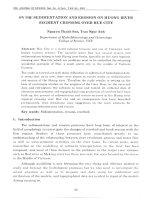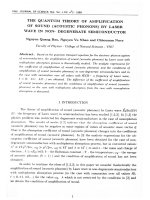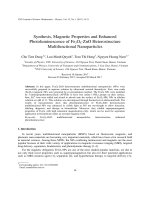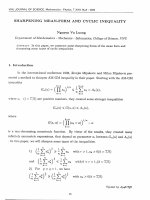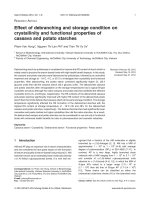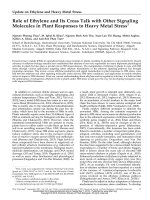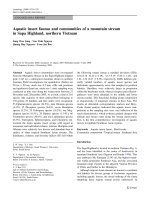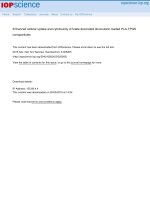DSpace at VNU: Language borrowing: theory and reality
Bạn đang xem bản rút gọn của tài liệu. Xem và tải ngay bản đầy đủ của tài liệu tại đây (254.03 KB, 5 trang )
DISCUSSION
LANGUAGE BORROWING: THEORY AND REALITY
Pham Hung Viet*, Ly Toan Thang
Vietnam Institute of Lexicography and Encyclopedia,
36 Hang Chuoi, Hai Ba Trung, Hanoi, Vietnam
Received 05 March 2017
Revised 16 May 2017; Accepted 18 May 2017
Abstract: The paper discusses the concept of language borrowing from different viewpoints and considers
approaches to that linguistic phenomenon, from traditional to modern ones concerning borrowings at different
levels in a language system, including phonetic, lexical and syntactic levels. These offer practical implications
to research on the issue of borrowing in the Vietnamese language at present.
Keywords: language contact, language borrowing, loan words
1. Introduction
2. The concepts of ‘borrowing’ / ‘loans’
World-reputable linguists claim that
languages and dialects do not exist in
vacuum; rather, they often have contact with
other languages and dialects. Such contact or
exposure results in ‘borrowed language’ or
language borrowing, which has long been a
recurrent topic of discussions from various
approaches by diferrent authors, particularly
after the two classic works of Uriel Weinrich
(1953) and Einar Haugen (1953).
In Vietnam, although there have been
some studies on the phenomenon of borrowed
words in Vietnamese from other languages
such as Chinese, French, etc., like the works
of Nguyen Tai Can, Phan Ngoc, Vuong Toan,
amongst others, a number of aspects and
issues remain untouched, even in the recent
fairly elaborate theoretical work of Nguyen
Van Khang (2007).
As far as studies on the phenomenon of
borrowing and loan words are concerned, the
recent few decades have witnessed increasing
focus on theoretical aspects with more
comprehensive insights in comparison with
the two classic works of Weinrich (1953) and
Haugen (1953).
When
researching
borrowing
phenomenon, most linguists tend to use
the term ‘borrowing’ or ‘loan’ (Russian:
Заимствование). In the particularly
frequent field of lexical borrowing, the term
‘loan word’ or ‘borrowed word’ (Russian:
заимствованное словo) sees the highest
use in contrast with the term ‘foreign word’
(Russian: иностранное словo). Although
these terms have become so popular for
a long time, not a few scholars argue that
they are not accurate because nothing is
returned from the ‘borrowing’ language to
the ‘lending’ language. In this line, several
attempts have been made to suggest other
terms so as to add higher accuracy to various
* Corresponding author. Tel.: 84-903257820
Email:
168
P.H.Viet, L.T. Thang / VNU Journal of Foreign Studies, Vol.33, No.3 (2017) 167-171
aspects of ‘borrowing’ phenomenon, for
example, importation, adoption, adaptation,
integration, etc.
Despite differences in concepts and
terminology, current researchers seem
to prefer the definition of Thomason and
Kaufman (1988:37) to the others 20 years
earlier, which states, “Borrowing is a kind
of blending or incorporation foreign features
to the language of an indigenous group by
the speakers of that language; although
this native language was maintained, it
experienced certain modifications due to
those additional features”. This definition is
believed to be better than that of Haughen
(1950: 212): “Borrowing is a ‘reproduction’
in one language of the patterns found earlier
in another language”.
Concerning the denotation and connotation
of the concept of ‘borrowing’ as well as
approaches to borrowing, recent decades
witness the following major emerging trends:
(i)The first trend considers ‘borrowing’
in a broader context, in which
‘borrowing’ is just one type of crosslinguistic influences or of contactinduced change. Language contact
includes many different phenomena
such as borrowing, convergence and
relexification. The most common
‘products’ of these phenomena are,
inter alia, code-switching, pidgins,
creoles, and mixed language.
(ii)The second trend considers ‘borrowing’
a ‘multidisciplinary’ issue, i.e. each
discipline would approach borrowed
words from a particular view such as
linguistics, anthropology, sociology,
psychology and ethnography. In
linguistics, besides traditional fields
which have long been interested in
the phenomena of borrowing such
as historical linguistics, comparative
linguistics, there are now interdisciplinary
research works such as socio-linguistics,
psychological linguistics and ‘cognitive
linguistics’. However, the most notable
emergence is ‘contact linguistics’. With
this new direction, the phenomenon of
borrowing will be considered from a
theory, from an approach that has many
newer, broader and deeper features than
traditional ones.
(iii) The third trend argues that traditional
researchers rely more on diachronic
linguistics and tend to investigate
the development of language and
language relations, the distinction
between the borrowed and native
characteristics in a particular language.
However, later research pays more
attention to the synchronic aspects of
borrowing, focusing on the distinction
between borrowing phenomena and
other language phenomena such
as
‘interference’,
‘transference’,
‘convergence’ and especially ‘codeswitching’. There have been meticulous
studies to find out the distinctive
features between the two phenomena:
borrowing and code-switching (see
overview of Romaine 1995). Another
noteworthy effort is in building lexical
borrowing universals like the ‘World
Loanword Database’ of 41 languages
(Haspelmath & Tadmor 2009).
(iv) The fourth trend agrees that research
on borrowing phenomena does
not merely deal with the results of
borrowing, but it needs to be deepened
from another perspective, which has
not received adequate attention so far.
It is the need to find out the answers
to such questions as: What are the
linguistic and non-linguistic processes
underlying borrowing phenomena?
How do these processes manage their
functions?
VNU Journal of Foreign Studies, Vol.33, No.3 (2017) 167-171
(v)The fifth trend supposes that traditional
studies of borrowing phenomena have
a tendency to explain language change
due to internal factors. However, later
research has shifted to external factors.
The work which triggered this contactinduced change of a language is the
book of the two authors Thomason and
Kaufman (1988).
(vi) The influence of language contact can
be ‘reciprocal’ / ‘two-way’ (mutual)
or just ‘one-way’ (non-mutual).
For example, Chinese exerted very
profound influence on the development
of Japanese, Korean, and Vietnamese,
but the opposite seems negligible.
When merely uni-directional, such
influence is likely to give rise to
‘linguistic hegemony’ as evidenced
in the languages of the ruling empires
in their colonies like Latin, Chinese,
Persian/Iranian, Portuguese, Spanish,
English, French, etc.
(vii)Borrowing can leave profound and
multifaceted impacts not only on the
lexicon, but also on the phonology,
morphology and syntax of the borrowing
language. Such impacts may extend as
deep as the ‘organic layer’ (stratum).
(viii)
To establish a necessary
distinction between the language that
borrows (e.g. new words) and the
language that lends (those words), it is
important to use the following pairs of
common terms:
+ Source language and Donor language
+ Recipient language and Target language
+ Borrowing language and Replica language
3. Different approaches to the study of
borrowing
It is significant to note that borrowing
phenomenon in general or loan words in
169
particular should be approached from different
views of various branches of linguistics as
well as from interdisciplinary stance.
From traditional perspective of historical
linguistics and comparative linguistics, there
are three common issues of interest to study
the phenomenon of borrowing: history of
language, language relations and language
change. For example, English loan words
will be reviewed in the process of English
language history, from Old English to Middle
English and Modern English. In that process,
English has borrowed from many prominent
languages such as Latin, French and Norse
(the language of the Vikings, Scandinave,
which was believed to originate from Proto
German). From the 9thcentury onward, English
borrowed many French and Norse words, the
point of time considered to be the end of Old
English and the beginning of Middle English.
From the perspective of sociolinguistics,
studies of borrowing phenomena concentrate
on influential factors which are socio-linguistic
in nature (see Nguyen Van Khang 2007).
It is worth noticing the notion of Weinrich,
Herzgod and Labob (1968) on the so-called
‘embedding problem’ and ‘constraints
problem’ related to social correlate. Some
other issues are also noted, namely:
+ ‘actuation problem’ and ‘transition
problem’, which refer to language
characteristics: How do lending languages
find way into borrowing languages? When do
they change their functions?
+ ‘evaluation problem’ concerning the
subjective evaluation of different researchers.
Also noteworthy is the notion of
‘social status’ of the lending and borrowing
languages. ‘Borrowing’ typically reflects the
social status of the relations between the two
languages. Consequently, two terms emerged:
‘Superstratum’ is used for the language with
higher social status and ‘Substratum’ for the
language with lower social status.
170
P.H.Viet, L.T. Thang / VNU Journal of Foreign Studies, Vol.33, No.3 (2017) 167-171
As mentioned above, with the emergence
of subfields or the movement of ‘contact
linguistics’ (see Winford 2003), borrowing
phenomena are considered from an approach
which has many new features. In the history
of research on this phenomenon, the basic
problems are discussed from language exposure
perspective. Since the time of Uriel Weinrich
(1953) and Einar Haugen (1953), for more
than 60 years, there have been many different
opinions on borrowing (see Thomason &
Kaufman 1988, Trask 2000, Van Coetsem 2000
Aikhenvald 2002, Heine and Kuteva 2005).
Among them, more notable are the followings:
+ Borrowing is usually associated
with situations of maintenance, whereas
interference is often associated with acquiring
a second language and language shift.
+ Borrowing is a type of characteristic
transference from one language to another.
+ Borrowing is an incorporation of foreign
features into the native language.
+ During the process of borrowing,
some pairs of terms should be distinguished:
‘importation’ vs. ‘substitution’; ‘adoption’ vs.
‘adaptation’; ‘adaptation’ vs. ‘integration’;
‘adoption’ vs. ‘imitation’.
We can be more objective with the
viewpoint of ‘contact language’ when it
is estimated that approximately 60-70%
of Vietnamese vocabulary were borrowed
from Chinese in different historical periods.
Similarly, when looking into English, in 1000
English words today, the average proportions
are as follows (from Roberts, 1965):
- Pure English: 32%
- Original French: 45%
- Original Latin: 17%
- Original German: 04%
- From other languages (like Scandinave): 02%
and according to the general estimate of many
scholars, the number of English loan words
may be more, 60%- 70% or 65%-75%!
4. Borrowing at different linguistic levels
Borrowing occurs not only at lexeme level
(although it happens most popularly) but also
from phoneme, morphology, syntax levels:
4.1. Phonetics
Languages usually borrow phonemes,
phonemic distribution context, or phonetic
rules from other languages. For example, in
Latvian and Finnish, the first syllable stress
was borrowed from Baltic region languages.
Diffusion phenomena of phonetic change
from [k] to [c] or from [ts] to [s] was borrowed
from a number of languages.
4.2. Morphology
It is very interesting that English has
borrowed affixes from many other languages.
Studies by the Russian scholar Volodarskaya
E. (2001) show the following results:
- Pure Anglo-Saxon: 11.7%, including
prefixes be-, for-, mid-, mis-, step-, twi-, un-,
etc.
- Original French: 16%, including prefixes
counter, de-, demi-, en-, in-, inter, re-, sur-, etc.
- Original Latin: 45%, including prefixes
ante-, bi-, co-, dis-, extra-, micro-, multi-,
non-, post-, pro-, semi-, sub-, super -, trans-,
vice-, etc.
- Original Greek: 26.7%, including
prefixes a-, anti-, auto-, di-, hyper-, mono-,
neo-, pan-, poly-, proto-, pseudo-, tri-, etc.
4.3. Syntax
It is obvious that the borrowing language
was influenced by a certain structural model
or a certain word order or one type of sentence
structure of the lending language (for example
subordinate clause is associated with the
main clause by conjunction). It can be seen
in various meticulous studies, for example,
‘Grammatical Borrowing in Cross-Linguistic
Perspective’ by Matras and Sakel (2007).
VNU Journal of Foreign Studies, Vol.33, No.3 (2017) 167-171
5. Conclusion
Borrowing is a common phenomenon
across languages in the world, which occurs
most frequently and apparently at lexical
level. It also occurs at phonetic, morphological
and syntactic levels to different degrees. It is
important to understand the causes and impacts
of language borrowing so as to properly
treat borrowing in general and loan words,
or ‘foreign words’ in particular. On the one
hand, this will help preserve the purity of the
national language, and on the other, make use
of the positive impacts of borrowed linguistic
features to enrich the national language.
171
Thomason S.G. & Kaufman T. (1988) Language
Contact, Creolization and Genetic Linguistics.
University of California Press.
Trask R. L. (2000) The Dictionary of Historical and
Comparative Linguistics. Edinburgh University Press.
Van Coetsem F. (2000) A General and Unified Theory
of the Transmision Process in Language Contact.
Heidelberg: Winter.
Volodarskaya E.F. (2001) “Zaimstovovanie kak
universal’noe lingvisticheskoe yavlenie”. In
Voprosy filologhii, No 1 (7), Moskva.
Weinrich U. (1953) Languages in Contact: Findings
and Problems. Linguistic Circle of New York.
Weinrich U., Labov W. & Herzgod M. I. (1968)
“Empirical foundations for a theory of language
change”. In Lehman W.P. & Malkiel (eds). Directions
for historical linguistics. University of Texas Prees.
Winford D. (2003) An introduction to contact linguistics.
Blackwell.
Vietnamese
References
Foreign languages
Aikhenvald A. (2002). Language Contact in Amazonia.
Oxford University Press.
Haspelmath M. & Tadmor U. (2009). Loanwords in the
world languages: a comparative handbook. Berlin:
Mouton de Gruyter.
Haugen E. (1950) “The analysis of linguistic borrowing”,
Language, 26.
Haugen E. (1953) The Norwegian Language in America:
A Study in Bilingual Behavior, Indiana University
Press.
Heine B. and Kuteva T. (2005) Language Contact and
Grammatical Change. Cambridge University Press.
Matras Y. and Sakel J. (2007) Grammatical Borrowing
in Cross Linguistic Perspective. Mouton de Gruyter.
Romaine S. (1995) Bilingualism. 2nd Ed. Blackwell.
Nguyễn Tài Cẩn (1979). Nguồn gốc và quá trình hình
thành cách đọc Hán Việt (The origin and formation
process of Sino-Vietnamese pronunciation). Nxb
Khoa học xã hội.
Nguyễn Tài Cẩn (1979). Giáo trình lịch sử ngữ âm tiếng
Việt (sơ thảo) (Coursebook on Vietnamese historical
phonetics (draft)). Nxb Giáo dục.
Nguyễn Văn Khang (2007). Từ ngoại lai trong tiếng
Việt (Foreign words in Vietnamese). Nxb Giáo dục.
Phan Ngọc – Phạm Đức Dương (1983) Tiếp xúc ngôn
ngữ ở Đông Nam Á (Language Contact in Southeast
Asia). Viện Đông Nam Á.
Phan Ngọc (1992) Mẹo giải nghĩa từ Hán Việt (Tips for
Sino-Vietnamese interpretation). Nxb Đà Nẵng.
Vương Toàn (1992) Từ gốc Pháp trong tiếng Việt
(Vietnamese words from original French). Nxb
Khoa học xã hội.
VỀ VẤN ĐỀ VAY MƯỢN NGÔN NGỮ:
LÍ THUYẾT VÀ THỰC TIỄN
Phạm Hùng Việt, Lý Toàn Thắng
Viện Từ điển học và Bách khoa thư Việt Nam, 36 Hàng Chuối, Hai Bà Trưng, Hà Nội, Việt Nam
Tóm tắt: Bài báo thảo luận về khái niệm vay mượn ngôn ngữ theo nhiều quan điểm khác
nhau, xem xét các cách tiếp cận đối với hiện tượng ngôn ngữ này từ truyền thống đến hiện đại ở
nhiều cấp độ vay mượn trong hệ thống ngôn ngữ như ngữ âm, từ vựng và ngữ pháp. Điều này có
ý nghĩa quan trọng đối với việc nghiên cứu vấn đề vay mượn trong tiếng Việt hiện nay.
Từ khóa: tiếp xúc ngôn ngữ, vay mượn ngôn ngữ, từ vay mượn

